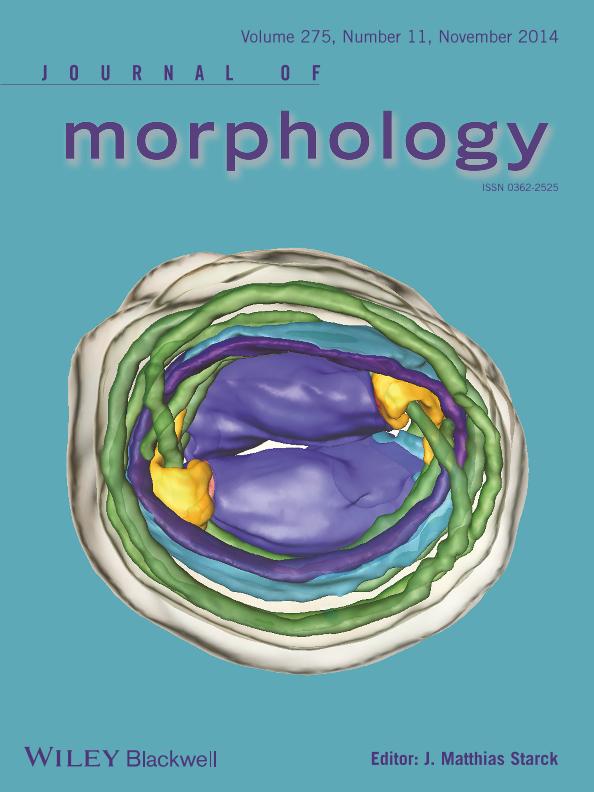Mostrar el registro sencillo del ítem
dc.contributor.author
Lipke, Elisabeth
dc.contributor.author
Ramirez, Martin Javier

dc.contributor.author
Michalik, Peter

dc.date.available
2017-06-29T21:00:17Z
dc.date.issued
2014-11
dc.identifier.citation
Lipke, Elisabeth; Ramirez, Martin Javier; Michalik, Peter; Ultrastructure of spermatozoa of orsolobidae (Haplogynae, Araneae) with implications on the evolution of sperm transfer forms in Dysderoidea; Wiley; Journal of Morphology; 275; 11; 11-2014; 1238-1257
dc.identifier.issn
0362-2525
dc.identifier.uri
http://hdl.handle.net/11336/19233
dc.description.abstract
Haplogynae are highly diverse with respect to the primary male genital system and sperm characteristics. Additionally, all sperm transfer forms (STF) known for spiders are present. Besides individually transferred sperm (cleistospermia), sperm are transferred as conjugates, both primary (synspermia) and secondary sperm conjugates (coenospermia, rouleaux) occur. Nevertheless, the ultrastructure of spermatozoa and STF are described for few Haplogynae and often only one representative species was studied, resulting in a superficial insight in the evolution of these traits. To elucidate the evolution of STF within Haplogynae we investigated representatives of four genera of the dysderoid family Orsolobidae. Our data show the presence of synspermia (Orsolobus, Osornolobus, Hickmanolobus, and Tasmanoonops) and also cleistospermia (Osornolobus). The occurrence of different STF within one family or even genus has not been described for any other spider taxon so far. Moreover, the synspermia of species of Tasmanoonops and Hickmanolobus were not covered by a secretion sheath suggesting a previously unknown strategy of transferring sperm that is possibly related to sperm residency time or female triggered processes after copulation. Based on serial ultrathin sectioning and subsequent 3D-reconstruction, we obtained detailed measurements revealing remarkable size differences of STF. To evaluate the previously suggested correlation with the most distal region of the spermophor inside the embolus (intromittent part of the copulatory organ) we measured the diameter of the spermophor using micro-computed X-ray tomography data to obtain corresponding morphometric parameters. Based on these data only two species show similarity in STF and spermophor diameter.
dc.format
application/pdf
dc.language.iso
eng
dc.publisher
Wiley

dc.rights
info:eu-repo/semantics/openAccess
dc.rights.uri
https://creativecommons.org/licenses/by-nc-sa/2.5/ar/
dc.subject
3d Reconstruction
dc.subject
Micro-Computer X-Ray Tomography
dc.subject
Palpal Organ
dc.subject
Cleitospermia
dc.subject
Synspermia
dc.subject.classification
Zoología, Ornitología, Entomología, Etología

dc.subject.classification
Ciencias Biológicas

dc.subject.classification
CIENCIAS NATURALES Y EXACTAS

dc.title
Ultrastructure of spermatozoa of orsolobidae (Haplogynae, Araneae) with implications on the evolution of sperm transfer forms in Dysderoidea
dc.type
info:eu-repo/semantics/article
dc.type
info:ar-repo/semantics/artículo
dc.type
info:eu-repo/semantics/publishedVersion
dc.date.updated
2017-06-28T19:41:41Z
dc.journal.volume
275
dc.journal.number
11
dc.journal.pagination
1238-1257
dc.journal.pais
Estados Unidos

dc.journal.ciudad
Hoboken
dc.description.fil
Fil: Lipke, Elisabeth. Ernst-Moritz-Arndt University of Greifswald; Alemania
dc.description.fil
Fil: Ramirez, Martin Javier. Consejo Nacional de Investigaciones Científicas y Técnicas. Oficina de Coordinación Administrativa Parque Centenario. Museo Argentino de Ciencias Naturales "Bernardino Rivadavia"; Argentina
dc.description.fil
Fil: Michalik, Peter. Ernst-Moritz-Arndt University of Greifswald; Alemania. American Museum Of Natural History; Estados Unidos
dc.journal.title
Journal of Morphology

dc.relation.alternativeid
info:eu-repo/semantics/altIdentifier/doi/http://dx.doi.org/10.1002/jmor.20298
dc.relation.alternativeid
info:eu-repo/semantics/altIdentifier/url/http://onlinelibrary.wiley.com/doi/10.1002/jmor.20298/abstract
Archivos asociados
